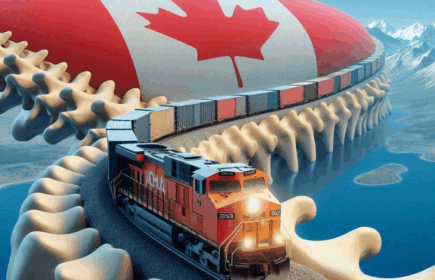As Canadian rail transportation spiralled downward to a complete halt in the latter part of August, the inability to move any products by rail in Canada signalled a crisis. On Thursday, August 22, 2024, both Canadian railways,
Canadian National Railway and Canadian Pacific Kansas City locked out workers at the same time as rail workers went on strike, after months of unsuccessful negotiations involving wages, pensions, and working conditions. That afternoon, the Federal Minister of Labour, Steven MacKinnon, ordered both railways and workers to enter
binding arbitration under the powers of the Canada Industrial Relations Board. Workers returned to work on Monday, August 26, and both railways resumed ‘regular’ business operations. In the past, short strikes have resulted in
‘regular’ operations taking weeks to resume and catch up, and the same should be anticipated to be the case this time as well. The result is that the movement of products was negatively affected for at least a month in Canada, costing the economy hundreds of millions.
Essential Service
One of the arguments being made against the government’s request for binding arbitration is that implementing arbitration was illegal, as rail transportation isn’t an essential service. Under the Canadian Labour Board,
rail is not deemed an essential service, hence the Teamsters Union were upset by this ruling to go to arbitration. Despite not being an essential service on paper, Labour Minister MacKinnon has powers federally under
Labour Code 107 to order binding arbitration.While it’s possible to build credible arguments that the transportation of some products, such as automobiles or lumber might not be essential services, it’s not possible to make a similar argument for the transportation of food. Given that vast amounts of food and food inputs are transported by rail in Canada, government policy needs to change to ensure that the movement of food is declared an essential service and that future actions by either railways or workers never negatively affect the availability of food in any Canadian grocery store.Certainly, a great deal of food is transported by truck in Canada, but this accounts for food transportation once the product has arrived in Canada. Think of all the items that you purchase regularly that are not made in Canada, such as European cheeses, Italian pasta, or bananas from Latin America, all of these products were moved by rail upon arrival in a Canadian port. While a good portion of perishable and frozen products are moved by rail, the portion of non-perishable products moved by rail is even higher. Given the small area in a grocery retail outlet that is used for inventory storage and the limited supply available in warehouses, had the rail strike lasted even two weeks, grocery store shelves would have begun to be depleted of some products and would have been as empty as they were during the initial stages of the Covid lockdown.
Transport as an importer, not a processor
We are great at producing raw goods, but we are not known for being big processors of food, specifically in the West. Given the geographic vastness of Canada, it’s cheaper to move food products by rail than it is by truck. It’s also faster. It’s very common to load rail cars, shipping off raw products and then later having the processed goods shipped, railed, or trucked back to us.Given how spread out our population and production is, the federal government has not undertaken any policy reforms designed to remove inter-provincial trade barriers,
which are estimated to cost the Canadian economy $32 billion per year. Federal governments have made progress on reducing international trade barriers through various agreements over the past 20 years, yet inter-provincial trade barriers remain a substantial and unaddressed barrier. An example of an inter-provincial trade barrier is the lack of regulatory harmonization in trucking regulations between provinces which results in trucks hauling food having to stop at provincial borders and needlessly wait to align with the next province’s regulations. These delays raise the cost of food for all Canadians by 8-14.5%. These truck transportation barriers mean that shifting food transportation from rail to truck isn’t an efficient option, as the time delays raise the cost of transporting food by truck.
Rail is the backbone of Canadian food
When it comes to rail, you may be surprised how essential it is to our lives. Daily goods and services move across the rails which affect us, whether it’s the crops we grow, the cars we drive, or the chemical goods that move safely across our nation. Rail for Canada has been a backbone, especially when it comes to our food. There have been numerous reports of the
increase in the use of food banks in Canada, if rail strikes prevent the transportation of food, this can severely impact the operations of food banks. As a nation that produces far more food than it consumes, it’s inconceivable that labour strife would result in empty grocery store shelves and contribute to increasing the unacceptable levels of food insecurity that already exist in Canada. However, given our dependence on our rail services and access over our vast nation, this is a reality. To ensure that grocery store shelves aren’t empty in the future and that Canadian food insecurity is not worsened due to labour battles, food transportation needs to be made an essential service in Canada. It is simply not possible to construct a logical argument in opposition to this.


